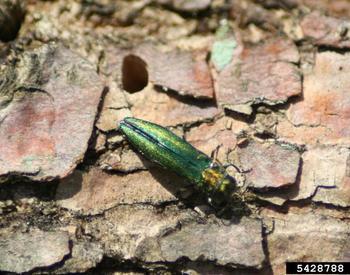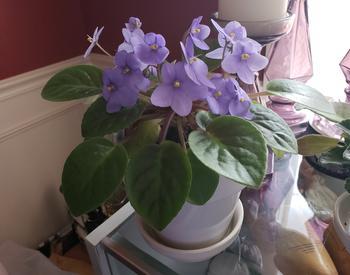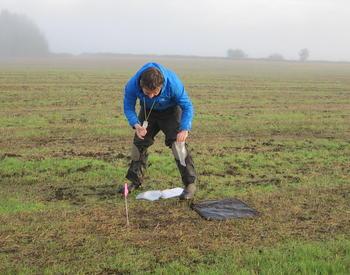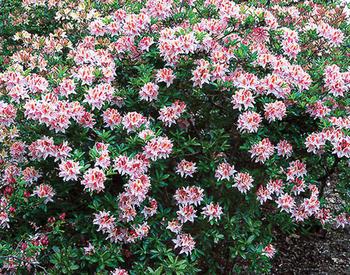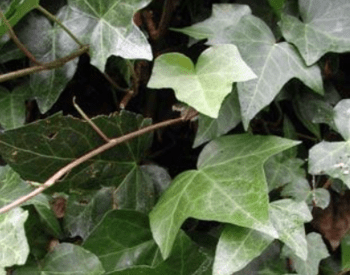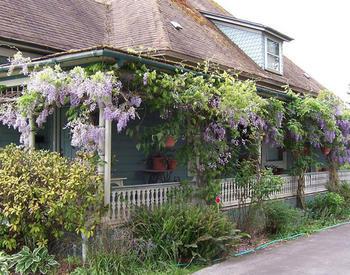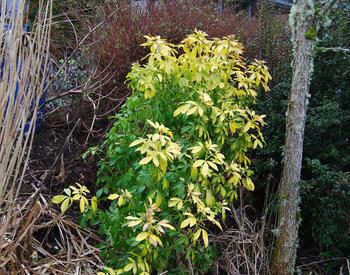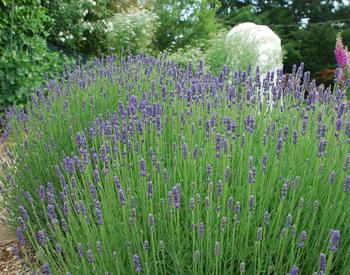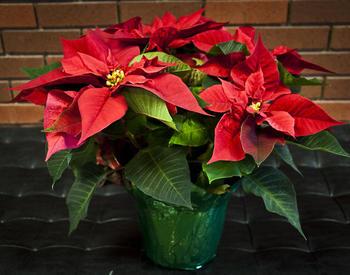Introduction
These guidelines are for landowners or land managers within Washington County or other known areas of emerald ash borer infestation who are responsible for protecting ash trees in landscapes, parks, natural areas or on their private property.
Emerald ash borer, or EAB, is an invasive insect devastating to trees in the genus Fraxinus, (commonly called ash). It is one of the most destructive forest pests in North America. Because of the threat this insect poses, communities and land managers should consider methods to protect or remove ash trees before they are damaged or killed. Recommendations for protection differ based on how near these communities are to areas where EAB has arrived.
In the early years of an infestation, EAB can take four to six years to kill a tree. Infested trees can appear healthy, but decline rapidly.
EAB is a threat only to certain trees in the family Oleaceae, including ash trees, olive trees and fringe trees. Trees in other families are not at risk from EAB. Despite their names, mountain-ash and Russian olive are not in the family Oleaceae and so are not at risk. Learn about identifying susceptible trees and recognizing damage from EAB.
Important: Washington county has a permanent ash material quarantine. See Oregon Department of Agriculture website.
What should you do? Take action
EAB damage to trees is severe and results in tree death. You must decide on what to do about ash trees threatened by EAB:
- Removal: Remove trees that are infested with EAB. Removal of threatened trees should be considered in specific situations. Replace trees with suitable species where appropriate.
- Treatment: Treat high-value ash trees with insecticides. Treatment with systemic insecticides can be effective in protecting trees. This could cost hundreds of dollars and must be repeated every few years, requiring a long-term commitment.
- Nothing (tree death): If the above actions are not taken, the infested tree will likely be killed by EAB. A dead or dying tree is hazardous. Removal of a dead tree can cost more than removal of a healthy tree.
Action: Removal
Removing ash trees when they are still alive is less expensive and more predictable than removing a dead tree when it threatens to break or fall. If beetles do not infest the wood, it can be used without further treatment. Removing ash before infestation also releases the growing space for planting a suitable replacement tree. However, it does reduce or eliminate the benefits that the established ash tree would have provided (shade, erosion control, wildlife habitat, air and noise buffers, etc.).
Removing all ash trees is not a realistic strategy for confining or eradicating EAB. If the beetles don’t find a suitable ash host tree near where they mature, they can fly several miles until they find more ash trees.
If EAB-infested trees are removed, there are specific protocols that must be followed to keep EAB from spreading. Avoid removing trees unless necessary during the EAB active period of April 1–Sept. 30 to prevent the spread of live insects. Removal should be done during EAB’s dormant period, Oct. 1–March 31.
Note: Movement of ash material out of quarantine is prohibited except when done under a compliance agreement with regulatory agencies. For more information, contact the Oregon Department of Agriculture or the Oregon Department of Forestry.
In some areas, you must also be careful about leaving the area where you removed trees open for other competitive species to move in. If you plan to remove trees, replant quickly where possible. Suitable species for replanting depend on your area. Source plants from reputable nurseries with clean and healthy nursery stock.
Action: Treatment
Insecticide treatments can be an effective way to protect trees from EAB. However, it is important to understand that once EAB arrives in an area, it doesn’t go away. Therefore, treatments to prevent damage from EAB must be done for the remainder of the tree's life.
Before deciding to treat, consider:
How many trees?
Is it one or many trees? Costs rise with the number of trees treated.
How much it will cost?
What are the costs of long-term treatment versus removal?
What is the value of the tree?
Is the tree in good condition? Is it one tree in a backyard, or a line of street trees providing shade? Is it located in a low-canopy neighborhood with few other mature shade trees? Is it a natural tree providing shade and a seed source for a stream or wetland? Would an alternative species be able to grow there?
How much would it cost to remove and replant an alternative species? Weigh that against the cost to treat the tree with pesticides.
What is the infestation level?
If your tree has a low level of infestation, a treatment applied correctly at the appropriate time of the year could provide protection and prolong your tree’s life. Generally, trees with greater than 20% canopy decline are not considered good candidates for treatment due to the amount of damage already done. If a tree is going to be protected from EAB, treatment needs to occur before infestation within the tree has reached this level.
Remember, though, that it can be difficult to detect when a tree is first infested. Signs of infestation may not be clear until a lot of damage has already happened. Learn how to recognize signs and symptoms of EAB damage
Only certain products can be used in Oregon against EAB
Oregon Department of Agriculture has a list of products approved for use against EAB, some of which require a pesticide applicators license to use.1
| Active ingredient (and trade name) | Professional applicator required (RUP) | Application methods | Effectiveness and application frequency | Application timing | Notes |
|---|---|---|---|---|---|
| Emamectin benzoate (Arbormectin, Tree-age) | Yes | Trunk injection | Excellent, one to three years | Mid to late spring after trees have leafed out | Most effective treatment choice, effective for up to three years. Systemic. |
| Azadirachtin (TreeAzin) | No | Trunk injection | Very good, one to two years | Mid to late spring after trees have leafed out | Effective after leaf-out; effectiveness varies by pest pressure. Systemic. |
| Imidacloprid (Merit, Xytect) | Yes | Soil drench, soil injection, trunk injection | Very good as trunk injection, one to two years. Good when applied in soil, one year. | Early to mid-spring or late fall | Classified as a neonicotinoid which may have restrictions in some areas. Systemic. |
| Dinotefuran (Zylam) | No | Soil injection, soil drench, trunk spray | Very good as trunk spray, one year. Good in soil, one year. | Mid to late spring after trees have leafed out | Increased risk of drift if sprayed. Systemic. |
| Imidacloprid + Clothianidin (Bayer Adv. Protect & Feed) | No | Soil drench | Varied, one year | Early to mid-spring | Imidacloprid may have restrictions in some areas (see above). Systemic. |
| Bifenthrin (Onyx) | Yes | Cover spray over tree surface | Fair, one year | Two applications at four-week intervals; first spray should occur at 450–550 degree days (50ºF, Jan.1) | Greater risk of drift compared to injections and drenches. Contact insecticide. |
| Cyfluthrin (Tempo) | No | Cover spray over tree surface | Fair, one year | Two applications at four-week intervals; first spray should occur at 450–550 degree days (50ºF, Jan.1) | Greater risk of drift compared to injections and drenches. Contact insecticide. |
| Spinosad (Entrust SC) | No | Cover spray (RUP), soil drench | Fair | Late June to early July | Bacteria-based contact insecticide. Risk of drift if sprayed. |
Action: Inaction and tree death
Unfortunately, EAB is currently an unstoppable pest. Oregon is the 36th state to be affected by EAB since the insect was first found in the United States in 2002. Though treatments are available to slow or prevent ash tree death, mature ash trees that are not treated or removed almost always become infested where EAB is present. Over time, these ash trees will die.
Dead trees can endanger people and property, due to their increased risk of falling and the unpredictability of decline. You may be responsible for injuries and damage to property that result from falling ash trees or branches on your property. Either treat trees, or remove and replace live trees with another species before they become infested.
Frequently asked questions
Will ODA, ODF or other public agencies remove my tree or force me to cut my trees down?
At this time no state or federal agencies in Oregon are requiring tree removal or treatment for EAB. They are encouraging landowners and land managers to carefully consider their situations and take appropriate action.
Are pollinators and beneficial insects at risk from insecticide treatments for EAB?
Pollinators and other “nontarget” organisms may be at risk from insecticides applied as cover sprays due to the risk of drift. North American ash species are wind-pollinated, and timing of applications should not coincide with pollen production. Systemic insecticides are a much lower risk to nontarget organisms that are not feeding on tree tissues. Research has shown that pesticide residues from systemic applications are not found in ash pollen. Systemic insecticides applied as liquid or granular soil drenches may negatively impact ground-nesting bees and other nontarget insects.
Are effective biological control options available to manage EAB?
Currently, biological control agents for emerald ash borer in the United States are limited. The Oregon Department of Agriculture is working with USDA-APHIS PPQ to distribute rigorously tested and approved agents. There are currently no effective agents against EAB commercially available to the general public. Some natural enemies of EAB, such as woodpeckers, have been known to feed on EAB in other states. These natural enemies do not appear to have an effect on tree death or the spread of EAB.
What kinds of trees should I replant if I cut down my ash trees?
If you are replanting within an urban area, consult your community's list of trees approved or recommended for replanting in street right of ways. You may also want to consult with your local nursery, garden center or city arborist for suitable replacement trees. Consider replacing urban ash with trees that are known to be resilient to heat and drought — conditions that are predicted to worsen in coming decades. Always source healthy trees free of diseases and pests. Researchers are studying which native trees may work best for replanting in natural or conservation areas in Oregon.
Can I resell the wood from ash I cut down?
Wood from cut ash trees that are suspected to be infested with EAB should be handled using the guidelines for removal above (See Action: Removal). Firewood harvested within the quarantine area must not leave the quarantine boundary. Generally speaking, firewood either inside or outside should not be moved more than 30 miles to prevent the spread of invasive insects. As a best practice, don't move firewood more than 10 miles from where it was harvested.
Firewood can be sterilized for forest insect and disease pests by heat-treating for 140°F (60°C) for 60 minutes. For more information, visit DontMoveFirewood.org. NOTE: No wood can be removed from a quarantined area without a compliance agreement from the Oregon Department of Agriculture.
What do I do if EAB is not yet established in or near my area?
If you are not located in or near a county with a confirmed EAB infestation, take the opportunity to plan ahead. Updated guidelines for Oregon are being developed. However, many other states with EAB infestations have planning guides for their residents and communities. See:
- Oregon’s Statewide EAB Plan. See section 5E: Quarantine/Regulation – Enforcement and Compliance.
- Guidelines to Slow the Growth and Spread of EAB (Minnesota Department of Agriculture)
- Emerald Ash Borer Information Network Publications and Resources
Can anyone cut my tree down? Whom should I hire to do the work correctly?
Tree removal and insecticide treatments can be dangerous if not done properly. To ensure proper timing and safety for tree removal or insecticide treatment, contact your local Oregon State University County Extension Office or find an arborist certified by the International Society of Arboriculture.
If you are a homeowner or landowner, keep in mind that not all treatments for EAB are necessary all the time. For example, if someone offers to remove or treat your ash tree, but you know that the nearest EAB infestation is not in your county or in an adjacent county, you may be at risk of being sold ineffective and untimely services.
Important: Emerald ash borer temporary quarantine adopted in Washington County effective Dec. 20, 2022–Nov. 11, 2023
In response to the confirmation of EAB in Washington County, the Oregon Department of Agriculture has enacted a countywide temporary quarantine (OAR 603-052-0135). The quarantine limits the movement of all plant parts of ash (Fraxinus species) and white fringe tree outside of Washington County. As of June 16, olive trees are excluded from the temporary quarantine. The EAB quarantine in Washington County restricts the movement of several tree debris items, including but not limited to: logs, green lumber, nursery stock, scion wood, bud wood, chips, mulch, stumps, roots, branches and firewood of hardwood species.
The purpose of the quarantine is to prevent the spread of EAB by restricting the movement of potentially infested tree debris to unaffected locations. To learn more about the quarantine or where you can properly dispose of quarantined tree debris, consult the EAB webpage.
A temporary quarantine may be extended, modified or made permanent depending on detection results from surveys performed over the next several months. The most likely outcome is that the quarantine will be made permanent though adjusted to include expanded options for treatment and movement of restricted materials covered under appropriate phytosanitary certification.
For more info on EAB and ash in Oregon
- OregonEAB.Com - Oregon Invasive Species Council’s EAB information hub
- Oregon Department of Agriculture: EAB
- Oregon Department of Forestry: EAB
- ODF: Oregon EAB risk map
- ODF: Community tree inventory
- Oregon State University
- Oregon Invasive Species Council Online Hotline
References
- Challenges, tactics and integrated management of emerald ash borer in North America Deborah G. McCullough (2019).
- Frequently Asked Questions Regarding Potential Side Effects of Systemic Insecticides Used To Control Emerald Ash Borer Jeffery Hahn, Daniel A. Herms, Deborah G. McCullough (2011).
- Table 1:
- Insecticide Options for Protecting Ash Trees from Emerald Ash Borer. 3rd Edition. North Central IPM Center. Daniel A. Herms, Deborah G. McCullough, David R. Smitley, Clifford S. Sadof, Frederick D. Miller, Whitney Cranshaw.
- 2011 Emerald Ash Borer National Research and Technology Development Meeting. Oct. 12–13, 2011, Wooster, Ohio. Report.
- Guidelines to Slow the Growth and Spread of EAB (Minnesota Department of Agriculture).
Acknowledgments
This information was compiled with input from the Oregon EAB Task Force. Thanks to Angie Ambourn and the Minnesota Department of Agriculture for their permission to use content from their guide: Guidelines to Slow the Growth and Spread of Emerald Ash Borer.
- 1The authors and the affiliated agencies and organizations of this guide do not endorse any chemical, brand, or method of application listed in this document, nor are they paid for listing any chemical, brand, or method of application. This document is for information only. Always follow label directions when applying pesticides.
¡Use los pesticidas con seguridad!
- Póngase ropa de protección y equipo de seguridad según las recomendaciones de la etiqueta. Báñese después de cada uso.
- Lea la etiqueta del pesticida—aunque lo haya usado antes. Siga al pie de la letra las indicaciones de la etiqueta (y cualquiera otra indicación que Ud. tenga).
- Tenga precaución al aplicar los pesticidas. Conozca su responsabilidad legal como aplicador de pesticidas. Usted puede ser responsable de heridas o daños resultantes del uso de un pesticida.
